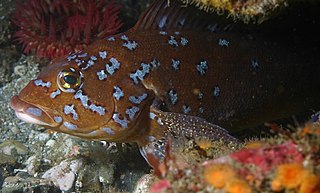
George Albert Boulenger was a Belgian-British zoologist who described and gave scientific names to over 2,000 new animal species, chiefly fish, reptiles, and amphibians. Boulenger was also an active botanist during the last 30 years of his life, especially in the study of roses.
Sauries are fish of the family Scomberesocidae. There are two genera, each containing two species. The name Scomberesocidae is derived from scomber and the Latin esox meaning pike.

The longjaw mudsucker is a species of goby found along the Pacific coast of California and Baja California. Known for its distinctive elongated jaws and robust body, this species can reach up to 21 cm in length, making it one of the larger gobies in its habitat. Adapted to estuarine environments, the longjaw mudsucker has evolved to survive short periods out of water, utilizing tidal mudflats and sloughs as its primary habitat.
George Sprague Myers was an American ichthyologist who spent most of his career at Stanford University. He served as the editor of Stanford Ichthyological Bulletin as well as president of the American Society of Ichthyologists and Herpetologists. Myers was also head of the Division of Fishes at the United States National Museum, and held a position as an ichthyologist for the United States Fish and Wildlife Service. He was also an advisor in fisheries and ichthyology to the Brazilian Government.

Anisotremus is a genus of grunts native to the eastern Pacific and western Atlantic Oceans. The name of this genus is compound of anisto meaning “different” and tremus meaning “hole”, referring to the different sized paired pores on each side of the head.

Sebastolobus, the thornyheads, is a genus of marine ray-finned fish belonging to the subfamily Sebastinae, the rockfishes, part of the family Scorpaenidae. These fishes are native to the northern and eastern Pacific Ocean. They are generally found in deep waters.
Maurice Kottelat is a Swiss ichthyologist specializing in Eurasian freshwater fishes.

Dicentrarchus is a genus of ray-finned fishes belonging to the family Moronidae, the temperate basses. The two species in this genus are found in the eastern Atlantic Ocean and the Mediterranean Sea. The species in this genus are economically important food fishes.

Blepsias is a genus of marine ray-finned fishes belonging to the family Agonidae, the poachers and related fishes. These fishes are found in the coastal northern Pacific Ocean from Japan to California.

Hexagrammos is a genus of marine ray-finned fishes belonging to the family Hexagrammidae, the greenlings. These fishes are found in the north Pacific Ocean.

Pleurogrammus is a genus of ray-finned fishes belonging to the family Hexagrammidae, the greenlings, known as Atka mackerels. These fishes are found in the northwestern Pacific Ocean.
Gerald Robert "Gerry" Allen is an American-born Australian ichthyologist. His career began in 1963, when he spent a semester at the University of Hawaii, where he also received a PhD in marine zoology in 1971. In 1972, Allen wrote his doctoral thesis on the systematics and biology of the anemone fish.

Genyatremus is a genus of marine ray-finned fish, sweetlips belonging to the subfamily Plectorhynchinae, one of two subfamilies in the family Haemulidae, it consists of four species. The name of this genus is a compound of genys meaning “chin”, a meaning “without” and tremus meaning “pore”, a reference to the lack of a central pore on the chin in the fishes in this genus.
John Ernest "Jack" Randall was an American ichthyologist and a leading authority on coral reef fishes. Randall described over 800 species and authored 11 books and over 900 scientific papers and popular articles. He spent most of his career working in Hawaii. He died in April 2020 at the age of 95.

Manonichthys is a genus of ray-finned fishes from the subfamily Pseudochrominae, which is one of four subfamilies in the dottyback family Pseudochromidae. They are found in the tropical eastern Indian Ocean and the western Pacific Ocean. Many of the species of Manonichthys live within the bodies of large sponges, the genus name references the Greek word for a kind of sponge, manon, in combination with the Greek word for "fish", ichthys.
Lubbockichthys is a genus of ray-finned fish from the Indo-Pacific region which belongs to the subfamily Pseudoplesiopinae, part of the family Pseudochromidae, the dottybacks. The species in this genus have small cycloid scales throughout their lives; some of their head bones have a weakly honeycombed surface; and the parietal bone encloses the rear section of the supratemporal laterosensory canal.
Pectinochromis is a monospecific genus of ray-finned fish from the subfamily Pseudoplesiopinae in the family Pseudochromidae, the dottybacks. The only species in the genus is Pectinochromis lubbocki, a small reef living dottyback from the Red Sea. This genus is the sister taxon to the genus Chlidichthys. The specific name honours the Cambridge University ichthyologist Roger Lubbock (1951–1981), in recognition of his work on the taxonomy of the subfamily Pseudoplesiopinae.
Helen K. Larson is an ichthyologist who specialises in the fishes of the Indo-Pacific.

Stichaeinae is a subfamily of marine ray-finned fishes, classified within the family Stichaeidae, the pricklebacks or shannies. These fishes are found in the North Pacific, Arctic and North Atlantic Oceans.
Gymnelinae is a subfamily of marine ray-finned fish belonging to the family Zoarcidae, the eelpouts. Most species are found in the North Pacific Ocean but one genus is cosmopolitan, and another is endemic to the Southern Ocean.











